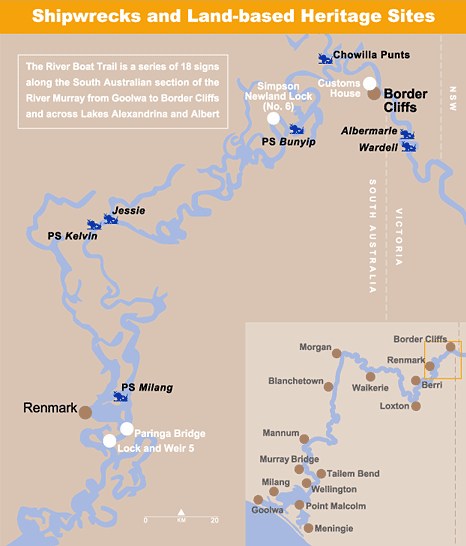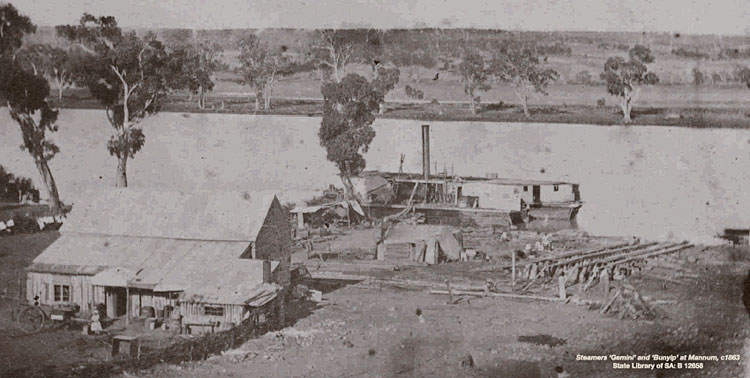
Formerly Port Murthoo, Border Cliffs was a customs outpost
 Border Cliffs
Border Cliffs
Before Federation in 1901, river boats had to pay taxes at the borders of the three colonies along the Murray, customs outposts were established at strategic points, including here at 'Port Murthoo'.
To stop smuggling at the South Australian border, 'Port Murthoo, a Customs Port Entry an Boarding Station' was gazetted in April 1884 and operated until 1902. The Customs House was built above the highest water mark and completed by December 1884.
The first Sub-collector of Customs was Robert Barker, whose salary included the house and an allowance for a servant. There was a large iron shed to store goods for the steamers and separate sheds for cargoes for sale in South Australia and New South Wales.
Very few actual taxes were collected at Port Murthoo; it seems that the officer's main role was to board vessels at the border and to seal any dutiable goods, which would then be charged at Renmark or Morgan.
In 1904 the abandoned Customs House became part of a station homestead and the area became known as 'Border Cliffs'. The Old Customs House is a significant State Heritage Place an is protected by the Heritage Places Act 1993 (SA).
River Wrecks
Barges Wardell and Albermarle
Two barges, no longer needed for work on the River Murray, have been abandoned in Millewa Creek, near the New South Wales border.
The wooden barge Wardell, abandoned in 1959, had a motor installed in the 1940s and worked as a snagging punt upriver from Renmark.
The other vessel, the composite barge Albermarle, was abandoned in the creek in 1932 and had last been employed carrying wood for the Renmark Irrigation Trust.
Wreck of the PS Bunyip
Bunyip Reach is named for one of the River Murray's most tragic shipping disasters. The loss of the Bunyip, with the deaths of four people, highlighted the hazards of the river boat trade and has become part of the lore of the upper Murray.
In December 1863 the sternwheeler, commanded by Captain William Randell and with two-fully laden barges, caught fire while the passengers and crew were at dinner. When he realised the danger, Randell attempted to turn the vessel out of the wind to quell the flames. Instead, the fire engulfed the wheelhouse forcing him to jump overboard. Unfortunately the wheel was locked on 'turn' and the Bunyip steamed in a circle, complicating efforts to abandon ship. When the engines stopped the vessel drifted to the bank. Of the twenty people on board, four died; a female passenger and her child burnt to death and two crewmen drowned.
One of the female passangers broke her leg tumbling into a ship's boat and another was severely burnt. The paddle steamer and its cargo, including 500 bales of wool, were completely destroyed. Only the iron hulls of both barges and a few smaller fittings were salvaged.

GPS: Zone 54 E 0496134 N 6240616
Panel in the carpark adjacent to the Customs House
Interpretive panels are located at:
River Boat Trail | Border Cliffs | Renmark | Berri | Loxton | Waikerie | Morgan | Blanchetown | Mannum
Murray Bridge | Tailem Bend | Wellington | Meningie | Point Malcolm | Milang | Goolwa
Please do not interfere in any way with ship-wrecks and land based heritage sites
Published with permission of Government of South Australia
Department for Environment and Heritage
Tell your friends you found this at murrayriver.com.au!
Copyright Discover Murray 2026. This site or any portion of this site must not be reproduced, duplicated, copied, sold, resold, or otherwise exploited for any commercial purpose that is not expressly permitted by DISCOVER MURRAY.






 Amy Shark The Solo Acoustic "Songs & Stories" Tour
Amy Shark The Solo Acoustic "Songs & Stories" Tour Lee Kernaghan Boys From The Bush The Concert
Lee Kernaghan Boys From The Bush The Concert The Australian Beach Boys Show
The Australian Beach Boys Show Kevin Bloody Wilson Aussie Icon Tour with special guest Jenny Talia
Kevin Bloody Wilson Aussie Icon Tour with special guest Jenny Talia Little By Little
Little By Little